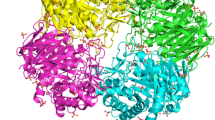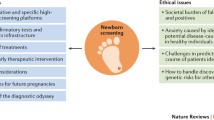Abstract
Lysosomal storage diseases are a group of disorders caused by defects in enzymes responsible for degradation of particular compounds in lysosomes. In most cases, these diseases are fatal, and until recently no treatment was available. Introduction of enzyme replacement therapy was a breakthrough in the treatment of some of the diseases. However, while this therapy is effective in reduction of many somatic symptoms, its efficacy in the treatment of the central nervous system is negligible, if any, mainly because of problems with crossing the blood-brain-barrier by intravenously administered enzyme molecules. On the other hand, there are many lysosomal storage diseases in which the central nervous system is affected. Results of very recent studies indicate that in at least some cases, another type of therapy, called substrate deprivation therapy (or substrate reduction therapy) may be effective in the treatment of neuronopathic forms of lysosomal storage diseases. This therapy, based on inhibition of synthesis of the compounds that cannot be degraded in cells of the patients, has been shown to be effective in several animal models of various diseases, and recent reports demonstrate its efficacy in the treatment of patients suffering from Niemann-Pick C disease and Sanfilippo disease.
Similar content being viewed by others
References
Aerts JM, Hollak CE, Boot RG, Groener JE, Maas M, 2006. Substrate reduction therapy of glycosphingolipid storage disorders. J Inherit Metab Dis 29: 449–456.
Ahmad I, Hunter RE, Flax JD, Snyder EY, Erickson RP, 2007. Neural stem cell implantation extends life in Niemann-Pick C1 mice. J Appl Genet 48: 269–272.
Beck M, 2007. New therapeutic options for lysosomal storage disorders: enzyme replacement, small molecules and gene therapy. Hum Genet 121: 1–22.
Bembi B, Marchetti F, Guerci VI, Ciana G, Addobbati R, Grasso D, et al. 2006. Substrate reduction therapy in the infantile form of Tay-Sachs disease. Neurology 66: 278–280.
Beutler E, 2006. Gaucher disease: multiple lessons from a single gene disorder. Acta Paediatr Suppl 95: 103–109.
Brady RO, 2006. Enzyme replacement for lysosomal diseases. Annu Rev Med 57: 283–296.
Brooks DA, Muller VJ, Hopwood JJ, 2006. Stop-codon read-through for patients affected by a lysosomal storage disorder. Trends Mol Med. 12: 367–373.
Capablo JL, Franco R, de Cabezón AS, Alfonso P, Pocovi M, Giraldo P, 2007. Neurologic improvement in a type 3 Gaucher disease patient treated with imiglucerase/miglustat combination. Epilepsia 48: 1406–1408.
Connock M, Burls A, Frew E, Fry-Smith A, Juarez-Garcia A, McCabe C, et al. 2006. The clinical effectiveness and cost-effectiveness of enzyme replacement therapy for Gaucher’s disease: a systematic review. Health Technol Assess 10: iii-iv, ix–136.
Dickson P, McEntee M, Vogler C, Le S, Levy B, Peinovich M, et al. 2007. Intrathecal enzyme replacement therapy: successful treatment of brain disease via the cerebrospinal fluid. Mol Genet Metab 91: 61–68.
Erickson RP, 2007. A first therapy for Niemann-Pick C. Lancet Neurol 6: 748–749.
Fan JQ, Ishii S, 2007. Active-site-specific chaperone therapy for Fabry disease. FEBS J 274: 4962–4971.
Gieselmann V, 2006. Reversibility of cellular and organ pathology in enzyme replacement trials in animal models of lysosomal storage diseases Acta Paediatr Suppl 95: 93–99.
Haskins ME, 2007. Animal models for mucopolysaccharidosis disorders and their clinical relevance. Acta Paediatr Suppl 96: 56–62.
Jeyakumar M, Thomas R, Elliot-Smith E, Smith DA, van der Spoel AC, d’Azzo A, et al. 2003. Central nervous system inflammation is a hallmark of pathogenesis in mouse models of GM1 and GM2 gangliosidosis. Brain 126: 974–987.
Kakkis E, McEntee M, Vogler C, Le S, Levy B, Belichenko P, et al. 2004. Intrathecal enzyme replacement therapy reduces lysosomal storage in the brain and meninges of the canine model of MPS I. Mol Genet Metab 83: 163–174.
Liscum L, Sturley SL, 2004. Intracellular trafficking of Niemann-Pick C proteins 1 and 2: obligate components of subcellular lipid transport. Biochim Biophys Acta 1685: 22–27.
Neufeld EF, Muenzer J, 2001. The mucopolysaccharidoses. In: Scriver CR, Beaudet AL, Sly WS, Valle D, eds. The metabolic and molecular bases of inherited disease. New York, McGraw-Hill: 3421–3452.
Pastores GM, Sathe SA, 2006. A chaperone-mediated approach to enzyme enhancement as a therapeutic option for the lysosomal storage disorders. Drugs RD 7: 339–348.
Pastores GM, Barnett NL, Kolodny EH, 2005. An open-label, noncomparative study of miglustat in type I Gaucher disease: efficacy and tolerability over 24 months of treatment. Clin Ther 27: 1215–1227.
Patterson MC, Vecchio D, Prady H, Abel L, Wraith JE, 2007. Miglustat for treatment of Niemann-Pick C disease: a randomised controlled study. Lancet Neurol 6: 765–772.
Piotrowska E, Jakóbkiewicz-Banecka J, Barańska S, Tylki-Szymańska A, Czartoryska B, Wegrzyn A, Wegrzyn G, 2006. Genistein-mediated inhibition of glycosaminoglycan synthesis as a basis for gene expression-targeted isoflavone therapy for mucopolysaccharidoses. Eur J Hum Genet 14: 846–852.
Platt FM, Neises GE, Reinkensmeier G, Townsend MJ, Perry VH, Proia RL, et al. 1997. Prevention of lysosomal storage in Tay-Sachs mice treated with N-butyldeoxynojirimycin. Science 276: 428–431.
Platt FM, Jeyakumar M, Andersson U, Heare T, Dwek RA, Butters TD, 2003. Substrate reduction therapy in mouse models of the glycosphingolipidoses. Philos Trans R Soc Lond B Biol Sci 358: 947–954.
Reuser AJ, Drost MR, 2006. Lysosomal dysfunction, cellular pathology and clinical symptoms: basicprinciples. Acta Paediatr Suppl 95: 77–82.
Roberts AL, Thomas BJ, Wilkinson AS, Fletcher JM, Byers S, 2006. Inhibition of glycosaminoglycan synthesis using rhodamine B in a mouse model of mucopolysaccharidosis type IIIA. 60: 309–314.
Roberts ALK, Rees MH, Kleje S, Fletcher JM, Bers S, 2007. Improvement in behavior after substrate deprivation therapy with rhodamine B in a mouse model of MPS IIIA. Mol Genet Metabol 92: 115–121.
Sturley SL, Patterson MC, Balch W, Liscum L, 2004. The pathophysiology and mechanisms of NP-C disease. Biochim Biophys Acta 1685: 83–87.
Suzuki K, Ezoe T, Tohyama J, Matsuda J, Vanier MT, Suzuki K, 2003. Are animal models useful for understanding the pathophysiology of lysosomal storage disease? Acta Paediatr Suppl 92: 54–62.
Świtoński M, Szczerbal I, Nowacka J, 2004. The dog genome map and its use in mammalian comparative genomics. J Appl Genet 45: 195–214
Węgrzyn G, Jakóbkieiwcz-Banecka A, Piotrowska E, Malinowska M, Maryniak A, Tylki-Szymańska A, et al. 2007. Gene expression-targeted isoflavone therapy (GET IT) for mucopolysaccharidosis type III (Sanfilippo disease): a pilot clinical trial. J Inherit Metabol Dis 30 Suppl 1: 116.
Zervas M, Somers KL, Thrall MA, Walkley SU, 2001. Critical role for glycosphingolipids in Niemann-Pick disease type C. Curr Biol 11: 1283–1287.
Author information
Authors and Affiliations
Corresponding author
Rights and permissions
About this article
Cite this article
Jakóbkiewicz-Banecka, J., Węgrzyn, A. & Węgrzyn, G. Substrate deprivation therapy: a new hope for patients suffering from neuronopathic forms of inherited lysosomal storage diseases. J Appl Genet 48, 383–388 (2007). https://doi.org/10.1007/BF03195237
Received:
Accepted:
Issue Date:
DOI: https://doi.org/10.1007/BF03195237




